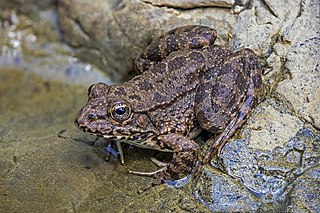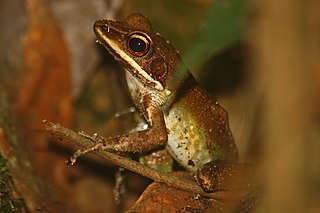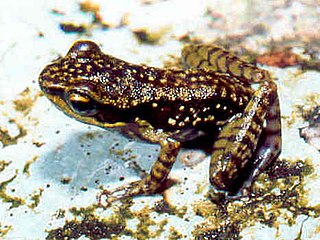
True frogs is the common name for the frog family Ranidae. They have the widest distribution of any frog family. They are abundant throughout most of the world, occurring on all continents except Antarctica. The true frogs are present in North America, northern South America, Europe, Africa, and Asia. The Asian range extends across the East Indies to New Guinea and a single species, the Australian wood frog, has spread into the far north of Australia.

Rana is a genus of frogs commonly known as the Holarctic true frogs, pond frogs or brown frogs. Members of this genus are found through much of Eurasia and western North America. Many other genera were formerly included here. These true frogs are usually largish species characterized by their slim waists and wrinkled skin; many have thin ridges running along their backs, but they generally lack "warts" as in typical toads. They are excellent jumpers due to their long, slender legs. The typical webbing found on their hind feet allows for easy movement through water. Coloration is mostly greens and browns above, with darker and yellowish spots.

Amnirana is a genus of frogs in the family Ranidae, "true frogs". The genus is primarily found in Sub-Saharan Africa, but one species occurs in parts of southern and southeastern Asia. Some of the African species are widespread but contain undescribed cryptic diversity. Most species have a white upper lip, and the genus is sometimes known as the white-lipped frogs.

Staurois is a small genus of minuscule true frogs. Most species in the genus are restricted to Borneo, but two species are from the Philippines. This genus is a quite ancient member of the true frog family, Ranidae. They are typically found in or near rapidly flowing, small rocky streams, and are sometimes known as splash frogs or foot-flagging frogs. The latter name refers to their unusual behavior of conspicuously waving their hindlegs and feet, as a way of signalling other members of the species. Similar behavior has also been documented in other frog genera, notably Hylodes and Micrixalus.

The Petropedetidae are a family of frogs containing three genera and 12 species. They are found in sub-Saharan tropical Africa and are sometimes known under common name African torrent frogs.
Amolops hainanensis is a species of frog in the family Ranidae that is endemic to southwestern and central Hainan, China. Its natural habitats are subtropical or tropical moist lowland forests and rivers. It is threatened by habitat loss. It is a sister taxa to both A. torrentis and A. daiyunnensis.

The common green frog is a frog species of in the true frog family Ranidae; some sources still use the old name Rana erythraea. It lives in Southeast Asia and is also known as green paddy frog, red-eared frog or leaf frog. The last name, however, commonly refers to the Neotropical tree frogs which make up the subfamily Phyllomedusinae. These are not closely related to H. erythraea, belonging to family Hylidae instead.

Pseudophilautus variabilis, also known as the variable bush frog or variable bubble-nest frog, is a species of frog in the family Rhacophoridae. This now extinct species was endemic to Sri Lanka. Despite extensive searches in recent times, it is only known from collections prior to 1858. The reasons for its disappearance are unknown but probably involve habitat loss.

Pelophylax is a genus of true frogs widespread in Eurasia, with a few species ranging into northern Africa. This genus was erected by Leopold Fitzinger in 1843 to accommodate the green frogs of the Old World, which he considered distinct from the brown pond frogs of Carl Linnaeus' genus Rana.

Hydrophylax gracilis, also known as Gravenhorst's frog, Gravenhorst's golden-backed frog, and Sri Lanka wood frog, is a species of frog in the family Ranidae. It is endemic to Sri Lanka.

Hylarana, commonly known as golden-backed frogs, is a genus of true frogs found in tropical Asia. It was formerly considered highly diverse, containing around 84 to 96 valid species, but taxonomic revision resulted in a major change in the contents of the genus, and today it is recognised as containing just four species.

Sylvirana is a genus of true frogs, family Ranidae, found in South and East Asia, from northeastern India in west to China in the north, Taiwan in the east, and Thailand in the south. Originally proposed as a subgenus of Rana in 1992, it has been considered both a full genus and a synonym of Hylarana. Its current recognition at generic level stems from molecular genetic analyses published in 2015.

Papurana is a genus of frogs in the family Ranidae, "true frogs". They are known from Southeast Asia, New Guinea, and northern Australia. Papurana daemeli is the only ranid frog found in Australia.
Hydrophylax is a monotypic genus of flowering plants in the family Rubiaceae. It was described by Carl Linnaeus the Younger in 1782. The genus contains only one species, Hydrophylax maritima, which is found in India, Sri Lanka and Thailand.
Papurana milleti is a species of true frog. Originally described in the genus Rana, then Hylarana and Indosylvirana, it is now placed in Papurana. It is native to Cambodia, China (Yunnan), Thailand, Vietnam, and quite possibly Laos. It is a locally common frog found by ponds and streams in seasonal tropical forests.
Phylohydrax is a genus of plants in the family Rubiaceae. Its species are native to Madagascar, Tanzania and South Africa.

Spinomantis bertini is a species of frog in the mantellid subfamily Mantellinae, endemic to Madagascar.

Hydrophylax bahuvistara, commonly known as the widespread fungoid frog, is a colourful frog found widespread in peninsular India, distributed in Maharashtra, Karnataka, Goa and Madhya Pradesh. It is very similar to another species with which it overlaps partly in range, Hydrophylax malabaricus.

Nidirana is a genus of true frogs (Ranidae) from East and Southeast Asia. They are commonly known as music frogs. This genus contains numerous species that were formerly classified in the genus Babina, which is thought to be its sister genus.














